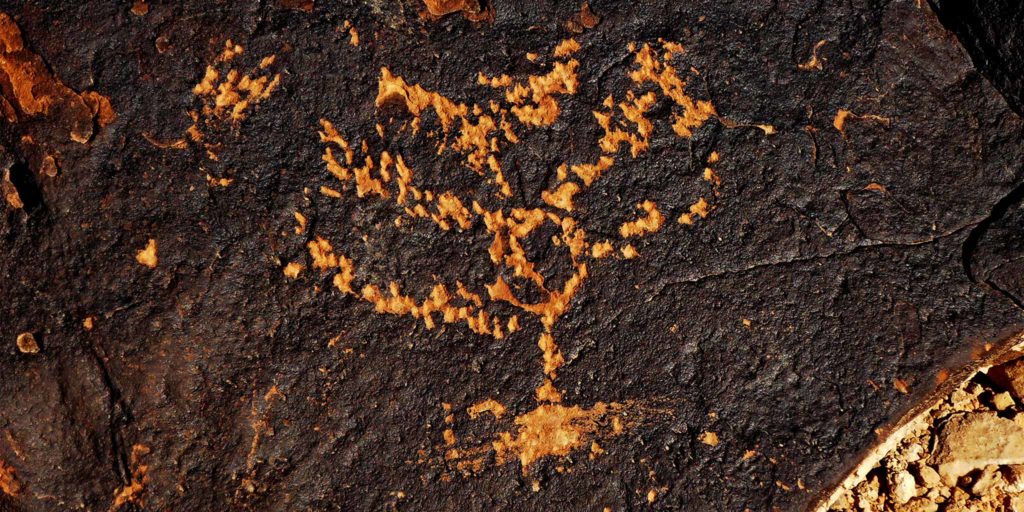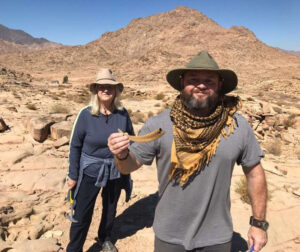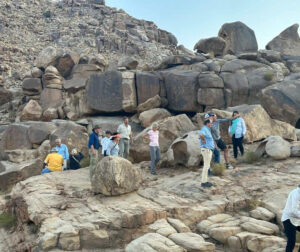Har Karkom: Is Mount Sinai in the Negev, Arabia, or Egypt?
Written by: Jennifer Bartlett

Could Har Karkom be the Mountain of God? Whether it is the true Mt. Sinai, or Kadesh Barnea, or simply an ancient flint quarry, this location offers many thought-provoking petroglyphs that suggest that this has been an important Jewish site for millennia.
Living Passages has taken our Berean friends to Egypt’s Sinai, to the newly open Saudia Arabia’s Jabal al Lawz, and we will also begin traveling to Har Karkom in the Negev desert.
What does “Har Karkom” Mean?
Scholars have long sought to discover the location of the ancient Mountain of God, upon which Moses received these laws. One contender is Har Karkom: Har meaning “mountain,” Karkom, derived from the ancient Persian karkum, which alludes to the saffron-producing crocus flower and means “yellow.”[1]
Mt. Karkom is located in the Negev region of Israel, just north of the River of Egypt, the Wadi Al-Arish,[2] which flows northwest into the Mediterranean Sea from the northern sector of the Sinai Peninsula. Notably, this area is home to thousands of petroglyphs—rock art.
Emblazoned in stone, the very words of God were etched into existence by His own finger.
Renowned Israeli archaeologist Israel Finkelstein notes that “Har Karkom differs from the main parts of the Negev Highlands by having a much larger number of rock drawings than at other sites.”[3] These include images of animals and people. What compels researchers to attribute these petroglyphs to early Israelites is the presence of a Menorah design and what seems to be a symbol of the Ten Commandments, both of which are decidedly Jewish motifs.
The mountain is thought to be the source of flint used to make knives for ritual purposes, such as circumcision and sacrifice, and there is evidence that worship rites took place on top of the mountain. Some think it may have been the site of Kadesh Barnea, from which point the Israelites sent spies into the land of Canaan,[4] and one researcher, Emmanuel Anati, believes it is a candidate for Mt. Sinai. He relates that this mountain fits the account of Exodus chapter 4, in which Moses, having accepted his assignment from God, left Midian to return to Egypt.
Meanwhile, “The Lord said to Aaron, ‘Go into the wilderness to meet Moses.’ So he went and met him at the mountain of God and kissed him’” (Ex 4:27). Anati notes, “That means that, according to the biblical view, the way from Midian to Egypt crosses Mount Sinai. Looking at the geographical map, with the Bible in one hand,” he postulates, “Har Karkom is the only locality among those proposed for Mount Sinai, which fits without any effort all these coordinates. It is also the only mountain that has recorded archaeological evidence of the cult role it had in the Bronze Age.”[5]
Check out our upcoming Israel tours to see if we have a spot open to visit Har Karkom. Or you can join us on one of our numerous new visits to Saudi Arabia to see the other potential real Mount Sinai site of Jabal al-Lawz.
[1] Sarah Oren, “Nature’s Hanukah Candle (Crocus hyemalis),” Neot Kedumim Park. https://www.neot-kedumim.org.il/index-plant-of-the-month/crocus-hyemalis/. Accessed 27 Nov 2019; see also Ahmad Reza Gohari, Soodabeh Saeidnia, and Mahdie Kourepaz Mahmoodabadi, “An Overview on Saffron, Phytochemicals, and Medicinal Properties,” Pharmacognosy Rev. 2013 Jan-Jun; 7(13): 61–66. PMC; NCBI. https://www.ncbi.nlm.nih.gov/pmc/articles/PMC3731881/. Accessed 27 Nov 2019.
[2] Steven Rudd, “Mt. Karkom, Israel,” Biblical Archaeology, www.bible.ca. Accessed 27 Nov 2019.
[3] Israel Finkelstein, “Raider of the Lost Mountain – An Israeli Archaeologist Looks at the Most Recent Attempt to Locate Mt. Sinai,” BAR 14:04, Jul/Aug (1988).
[4]Ibid.
[5]Anati, Emmanuel, “Har Karkom and Mount Sinai: Exegesis and Topography,”



